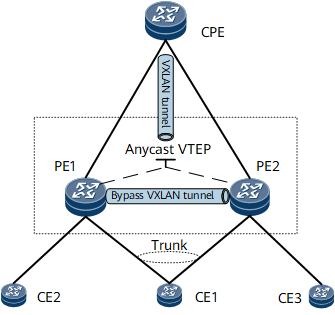Configuring the Dynamic IPv6 VXLAN Active-Active Scenario
In scenarios where an IPv6-based data center is interconnected with an enterprise site, a CE can be dual-homed to an IPv6 VXLAN to implement rapid convergence if a fault occurs, thereby enhancing access reliability and improving service stability.
Context
On the network shown in Figure 1, CE1 is dual-homed to PE1 and PE2. Both PEs use the same virtual address as an NVE interface address (namely, an Anycast VTEP address) at the network side. In this way, the CPE is aware of only one remote VTEP address. To allow the CPE to communicate with PE1 and PE2, a VTEP address must be configured on the CPE to establish an IPv6 VXLAN tunnel with the Anycast VTEP address.
The packets from the CPE can reach CE1 through either PE1 or PE2. However, when a single-homed CE (CE2 and CE3 in this example) exists on the network, the packets from the CPE to the single-homed CE may need to detour to the other PE after reaching one PE. To ensure PE1-PE2 reachability, a bypass VXLAN tunnel must be established between PE1 and PE2.
Procedure
- Configure AC-side service access.
- Configure an IPv6 VXLAN tunnel between the CPE and each PE using BGP EVPN. For details, see Configuring an IPv6 VXLAN Tunnel.
- Configure a bypass VXLAN tunnel between PE1 and PE2.
- Configure FRR on each PE.
For Layer 2 communication:
- Run evpn
The EVPN view is displayed.
- Run vlan-extend private enable
The function to add the VLAN private extended community attribute to routes to be sent to a peer is enabled.
- Run vlan-extend redirect enable
The function to redirect the received routes that carry the VLAN private extended community attribute is enabled.
- Run local-remote frr enable
Local-remote FRR is enabled.
- Run quit
Exit the EVPN view.
- Run commit
The configuration is committed.
- Run evpn
For Layer 3 communication:
- Run bgp as-number
The BGP view is displayed.
- Run ipv6-family vpn-instance vpn-instance-name
The BGP-VPN instance IPv6 address family view is displayed.
- Run auto-frr
BGP auto FRR is enabled.
- Run peer { ipv6-address | group-name } as-number as-number
A peer IP address and the number of the AS where the peer resides are specified.
- Run advertise l2vpn evpn
The function to advertise EVPN IP prefix routes from a VPN instance is enabled.
- Run quit
Exit the BGP-VPN instance IPv6 address family view.
- Run quit
Exit the BGP view.
- Run commit
The configuration is committed.
- Run bgp as-number
Verifying the Configuration
After configuring a dynamic IPv6 VXLAN active-active scenario, verify the configuration.
- Run the display bridge-domain [ binding-info | [ bd-id [ brief | verbose | binding-info ] ] ] command to check BD configurations.
- Run the display interface nve [ nve-number | main ] command to check NVE interface information.
- Run the display evpn vpn-instance command to check EVPN instance information.
- Run the display bgp evpn peer [ [ ipv6-address ] verbose ] command to check information about BGP EVPN peers.
- Run the display vxlan peer [ vni vni-id ] command to check the ingress replication lists of all VNIs or a specified one.
- Run the display vxlan tunnel [ tunnel-id ] [ verbose ] command to check IPv6 VXLAN tunnel information.
- Run the display vxlan vni [ vni-id [ verbose ] ] command to check IPv6 VXLAN configurations and the VNI status.
